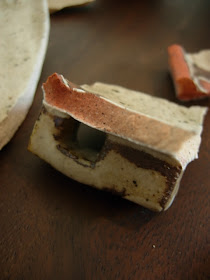

One received the last of the packages this week. The tea came in perfect shape. But unfortunately this beautiful tang gwan by Korean ceramic master Uh Sang Myung came in many little pieces despite overly vigilant packing.
Even in small shards it emanates brilliance.
The seemingly useless broken pieces do teach us though. They allow us to take a peak at the clay used for such a piece. They allow us a glimpse at the artist ingenious techniques, things that we couldn't know with a piece intact.


For instance, we can see how the base of the tang gwan is quite thick. As we move up the sidewall we notice it thins out then, as it approaches the rim, it thickens once again. Its form is marvelous.



What is most interesting about this piece is that Uh Sang Myung used red clay at the top near the rim but used a different clay for the main body and base. This is beautifully illustrated in some of the shards that show how the clay slowly picks up a pinky-orange as it nears the rim. Following this progression is like watching as the sun slowly sets before disappearing. Breathtaking.
Above all, these broken pieces remind us what is truly of value in our lives...
When we have lived as much as we are going to, arriving at life's last stop,
is there a single solitary thing that will come with us?
The things I possess right now are not originally mine.
They are only things that have been placed in my care temporarily.
Whether material objects or fame, intrinsically none of it can be my possession.
All these things are just secondary, following me along like a shadow, as I reside here in this space for the moment.
An excerpt from At the Last Stop of Life by Beop Jeong found in May All Beings Be Happy
Peace
My condolences. How strange to blend two clays. Really makes you appreciate the piece even more; blending two clays for a piece that will expand and contract with heat requires a great deal of skill.
ReplyDelete,.two pics from buttom supposed using different clays to only jar ,. thats quit difficult do that ,. maybe ? ido not know ,.we used do only from one piece of clay ,. maybe is due to different temperature in kiln ,. you have to look for a surface of clay not color ,. nice day ,.
ReplyDeleteJason,
ReplyDeleteUh Sang Myung is a master indeed. The expanding and contracting perhaps was, in the end, the downfall of this beautiful piece. Although one applied some heat and let it dry out for a few days before wrapping it, when unwrapped some slight moisture could be detected.
This moisture, if still trapped in the course body of the tang gwan, would have expanded and contracted as it encountered the frigid winter climate of the Canadian prairies on route from the comparably mild weather of Korea. Thereby significantly weakening it, making it ultra susceptible to cracking or shattering.
This characteristic of the tang gwan to absorb water through its course body allowed it to transform water in a way that few other tang gwans could ever replicate.
Tsultrim topden,
Hummm... perhaps the colour change was due to the firing in the wood kiln. The upper rim of the tang gwan would have been the only directly exposed clay to the heat of the kiln. Perhaps some reaction to the heat caused this? Could it have also been dyed or altered in someway to achieve this effect?
Is there any master potters out there that could offer us some insights?
Peace